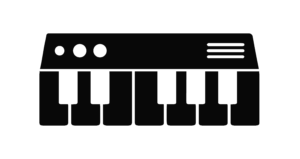Blog Search:
balance rail
The balance rail the the rail that runs underneath the centre of the key-bed. It holds each key in resting position via a pin. When a key is pressed it will pivot on the balance rail, pushing the rear of the key up to engage the action mechanism. Therefore acting as a fulcrum point. On […]
front rail
The front rail is the wooden rail at the front of the keyboard (as you are in front of it) that holds the front rail key pins. Its function is to provide a resting spot for the key when it has been pressed. A felt bushing is placed on each pin to stop the key […]
fly
A component of the Wurlitzer piano action. Its role is to hold the hammer which strikes the reed by being pushed by the lower action (called the whip assembly). It works by the key being pressed which triggers the whip assembly which in turn pushes the fly towards the reed. On the underside of the […]
harp
In electric piano terms, the harp is the part of the action that houses the tone-bar assembly on a Rhodes, or the reeds on a Wurlitzer. It is so-called because in and of itself it is able to generate the notes needed for the instrument to work (i.e. running your hand across it like a […]
hammer
In piano terms, a hammer is the system that strikes the string, tine, or reed to generate a note. When a key is pressed, the lower action mechanism triggers the hammer to propel towards the string, tine, or reed in question. On acoustic pianos and Wurlitzers, hammers are made using compressed felt (though on a […]
reed
A reed is a flat metal strip on a Wurlitzer piano that is struck by a hammer to generate a tone. On each reed is a pyramid shaped section of solder which allows the reed to be tuned. The heavier the reed, the lower it is in pitch, and vice-versa. It is attached to the […]
hum shield
The hum shield is an L-shaped metal frame on Wurlitzer 200 series pianos that covers the reed-bar assembly and piano action. It is designed to help eliminate buzzing and vibrations that could be transferred into the pick-ups on the reed bar. Combined with anti-vibration foam pads, it can be a very effective way of minimizing […]
key dip
Key dip is the distance the key on a piano travels between its rest position and the position when the key is pressed. This is usually 10mm or 3/8 of an inch. It is adjusted by adding or removing paper punchings to the front rail of the key. A shallower key dip can lead to […]
key levelling
The process of regulating the white and black keys of a keyboard. It usually involves adjusting the side-play, squaring, and spacing of keys, and setting the key height and key dip.
key height
Key height is the setting of the correct height of the white and black keys for the entire keyboard. It is adjusted by adding or removing paper punchings to the balance rail of the key. Even key height is essential to even regulation and good appearance of a piano. Key height adjustments also affect key […]

